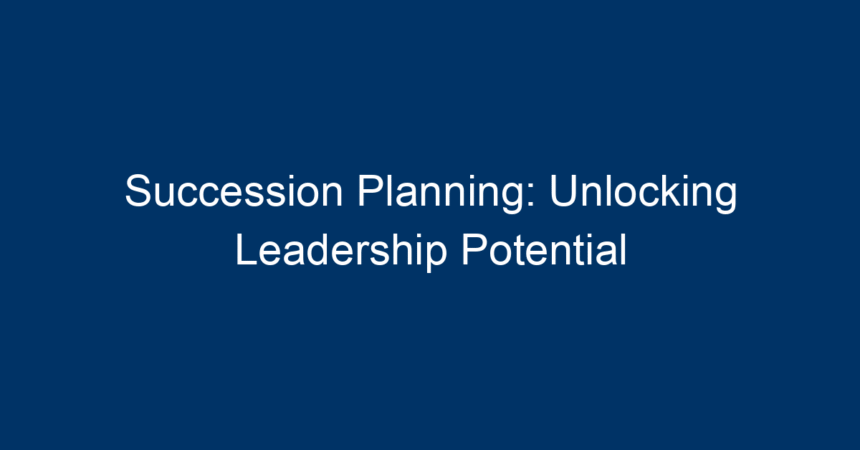Introduction: The Importance of Succession Planning
In today’s rapidly changing business environment, organizations must prepare for the future—both for challenges and growth opportunities. This is where succession planning comes into play. Often overlooked, effective succession planning is not just about identifying a replacement for a key position; it’s about unlocking the full potential of your leadership team and ensuring a smooth transition when the time comes. By investing in succession planning, companies can foster a culture of leadership, enhance employee engagement, and ultimately drive long-term success.
What is Succession Planning?
Succession planning is a strategic process aimed at identifying and developing internal personnel to fill key leadership roles within an organization. This proactive approach helps ensure that leadership capabilities are nurtured over time, allowing for a smoother transition when vacancies arise. Organizations with a solid succession plan are better equipped to maintain their competitive edge since they can seamlessly transition leaders who embody the company’s values and mission.
Why is Succession Planning Essential?
-
Mitigating Risk: Unexpected departures can leave a leadership void, negatively impacting operations. A well-defined succession plan minimizes the risk associated with key personnel losing their jobs unexpectedly.
-
Promoting Talent Development: Succession planning encourages organizations to invest in employee development. This cultivation of talent not only prepares individuals for future roles but enhances morale and retention levels.
-
Maintaining Organizational Knowledge: As experienced leaders transition out, they take valuable knowledge with them. Succession planning ensures that this essential expertise is passed down to future leaders.
- Strengthening Company Culture: By preparing internal employees for leadership roles, organizations foster a sense of loyalty and alignment with company values—crucial components of a healthy workplace culture.
Steps to Effective Succession Planning
1. Assess Your Current Leadership Needs
Before diving into succession planning, it’s essential to assess your current and future leadership needs. Consider:
- What roles are critical to your organization?
- What skills and competencies are required for these positions?
- How can you align these needs with your organization’s strategic goals?
Taking a comprehensive inventory of current roles will ensure that your succession planning is aligned with business objectives.
2. Identify High-Potential Employees
Once you have a clear understanding of your leadership needs, it’s time to identify high-potential employees within your organization. Look for individuals who:
- Demonstrate strong performance in their current roles
- Show leadership capabilities and a willingness to learn
- Align with the organization’s values and mission
Consider implementing a talent review process that includes feedback from managers, peer assessments, and self-evaluations to get a holistic view of potential candidates.
3. Create a Development Plan
Having identified your high-potential employees, the next step is to craft a personalized development plan for each individual. This plan should include:
-
Mentorship Opportunities: Pair high-potential employees with seasoned leaders for guidance and support.
-
Training Programs: Invest in leadership training programs tailored to the specific needs of the employee and the organization.
- Project Assignments: Assign individuals to lead special projects or cross-functional teams that allow them to gain practical experience and demonstrate their abilities.
4. Monitor Progress and Re-evaluate
Succession planning is an ongoing process. Regularly monitor the progress of your high-potential employees and re-evaluate your succession plans as necessary. Factors to consider include:
- Changes in business objectives
- Employee performance metrics
- Feedback from leadership assessments
Make adjustments as needed to ensure your succession plan remains relevant and effective.
Common Challenges in Succession Planning
Although succession planning offers numerous benefits, there are challenges organizations may encounter, including:
-
Resistance to Change: Employees may resist new initiatives, particularly if they feel threatened by the prospect of others moving up the ladder.
-
Identifying the Right Talent: It can be challenging to determine which employees truly possess the potential to be future leaders.
-
Lack of Formalized Processes: Without a clear established process, efforts at succession planning may become fragmented and ineffective.
- Poor Communication: Succession planning should be a clear and open process. Lack of communication often leads to confusion and negative morale.
Overcoming Challenges
-
Foster a Culture of Openness: Communicate the importance of succession planning to all employees, making it clear that this is an opportunity for growth rather than a threat.
-
Take a Holistic Approach: Develop formal processes to assess and nurture talent.
- Regularly Assess and Communicate: Ensure that feedback mechanisms are in place so that employees feel their progress is being acknowledged.
The Role of Technology in Succession Planning
In the digital age, technology can significantly enhance succession planning. Organizations can leverage software tools and platforms to:
- Track employee performance and development.
- Facilitate communication and feedback between employees and mentors.
- Maintain a comprehensive record of potential successors, including their skills and readiness for advancement.
Using technology not only streamlines processes but also enables organizations to make data-driven decisions.
Conclusion: Taking Action for Future Leadership
As we’ve explored, succession planning is a vital component of organizational strategy. It not only safeguards your organization against the unexpected but also nurtures talent, strengthens company culture, and boosts long-term success. By following the outlined steps—assessing your leadership needs, identifying high-potential employees, creating development plans, and continuously monitoring progress—you can create a robust succession plan that unlocks the leadership potential within your organization.
Actionable Insights:
-
Initiate a Talent Assessment: Start by assessing your current leadership roles and identifying high-potential employees.
-
Invest in Development: Develop customized growth plans for your future leaders to enhance their skills and capabilities.
-
Foster Strong Mentoring Relationships: Pair potential leaders with mentors who can guide them through their career paths.
- Regularly Review and Update: Treat succession planning as a dynamic process that requires frequent reevaluation and updates in response to changes within the organization.
By prioritizing succession planning today, you set the stage for a stronger, more resilient organization tomorrow.




